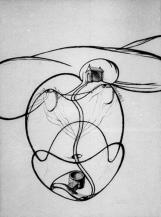



All texts copyright Richard Shillitoe
interior landscape
1947
Ink drawing.
16 x 12¼in. (41.5 x 31.5cm.) (ss)
Provenance
NT then the Royal Cornwall Museum, Truro.
Exhibited
London, Mayor Gallery, 1947, (drawings), no. 14.
Penzance, Newlyn Gallery, 1976, no. 41.
St. Ives, Tate Gallery, 2009.
Literature
Ratcliffe, 2007, ill. b/w pl. 41.
The technique is superautomatism. Colquhoun refers to this work in The Living Stones: Cornwall. In a
passage dealing with her response to the ancient landscape around Brane, Cornwall, she invokes the
memory of St. Euny:
Her strange powers, unused, seemed to hover about the grey hill, the unchannelled
water, the rank leaf. A presence that had once been drawn back into soil, weather and
plant, to become one of the ‘self-born mockers of man’s enterprise.’
I expressed in an ink drawing called Interior Landscape something of this semi-human
entity who still pervades the place. (p. 58)
St Euny was a fifth century saint who is said to have arrived in Cornwall from Ireland. His feast day is
the first of February, the pagan festival of Imbolc. Imbolc is a time of purification and rebirth,
traditionally celebrated at holy wells. St. Euny is usually regarded as a male, although in the passage
quoted above, and in the drawing, Colquhoun clearly identifies her as female.
Naturalistically drawn objects that include a well, a temple and pitchers of water are features that lie
both on and within a more abstract landscape formed of curving sweeping arcs. The objects can be
read as both sensory organs and as female body parts. The pitchers of water form eyes/breasts, the
well both mouth and vagina. They are linked by lines that are paths, vessels and nerves.


















